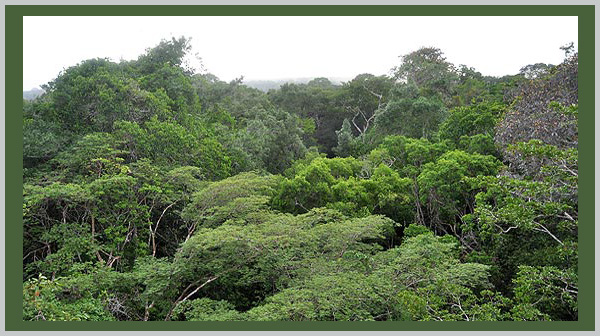
Spotlight on Tropical Rain Forests
Tropical rain forests once blanketed the Earth like a wide green belt around the equator. Just a few thousand years ago rain forests covered 14 percent of the Earth’s land surface, or 5 billion acres. Humans already have destroyed half of this forest area, with most damage occurring in the last 200 years.
With just 2.5 million square miles (647 million hectares) of tropical rain forest remaining, we continue to lose an estimated 93,000 square miles (150,000 square km) a year. And although tropical rain forests now cover just 2 percent of the globe, they are home to more than half the world’s living plant and animal species.
According to a report by the United States’ National Academy of Sciences, a 4-square-mile (1,000 hectare) patch of rain forest contains up to 1,500 species of flowering plants, as many as 750 species of trees, 125 species of mammals, 400 species of birds, 150 species of butterflies, 100 species of reptiles, and 60 species of amphibians.
It is not only quantity of life, but diversity as well, that makes rain forests so vital. Some of the strangest and most beautiful plants and animals are found in rain forests, and undoubtedly there are just as many we do not even know about.
Rain forests are the predominant natural vegetation throughout the wet tropics. The defining characteristics of tropical a rain forest are temperature and rainfall. Wherever temperature is high enough and rainfall heavy and regular enough, there is rain forest.
Rain forests experience from 40 to 400 inches (100 to 1000 cm) of rain a year and an average temperature of about 80° F (26° C), with no pronounced cold or dry spells.
Rain forests are being eliminated for timber, minerals, agriculture, and human settlement. Other motives, such as the desire to conquer nature or to control unoccupied territory, also are factors in deforestation.
Overpopulation and peasant agriculture is often cited as the cause of deforestation. This may be true of some African and Asian countries, but generally countries with the most tropical rain forest are those with the lowest human population densities.
It is not population pressure but the inequitable distribution of land ownership that creates the most pressure on tropical forests. In many developing countries the government and a very small percentage of people own the majority of the land.
Logging, mining, and other industrial activities are not driven primarily by local population pressures. Industrial development and settlement often go hand in hand because roads give access to cleared land. Most attempts to turn tropical forest into farmland have failed, resulting in damaged soil and disrupted water systems, leaving settlers even more desperate for land.
In Central and South America, cattle ranching for beef export to northern countries is the chief culprit in deforestation. Ranching, logging, and mining are prime examples of destructive practices that profit a few but destroy the forest for all.
In contrast, intact tropical rain forests provide long-term, widely distributed benefits, including protection of wildlife, water catchments, soil, food, fuel, medicines, building materials, and global climate stabilization.
Related Topics:
Case study on Golden Lion Tamarin
Case study on Malayan Sun Bear
Case study on Indian Python
Case study on Hyacinth Macaw
Spotlight on Global Climate Change
Explore:
Click here for Endangered Species Classroom Activities
Click here for Endangered Species Classroom Glossary